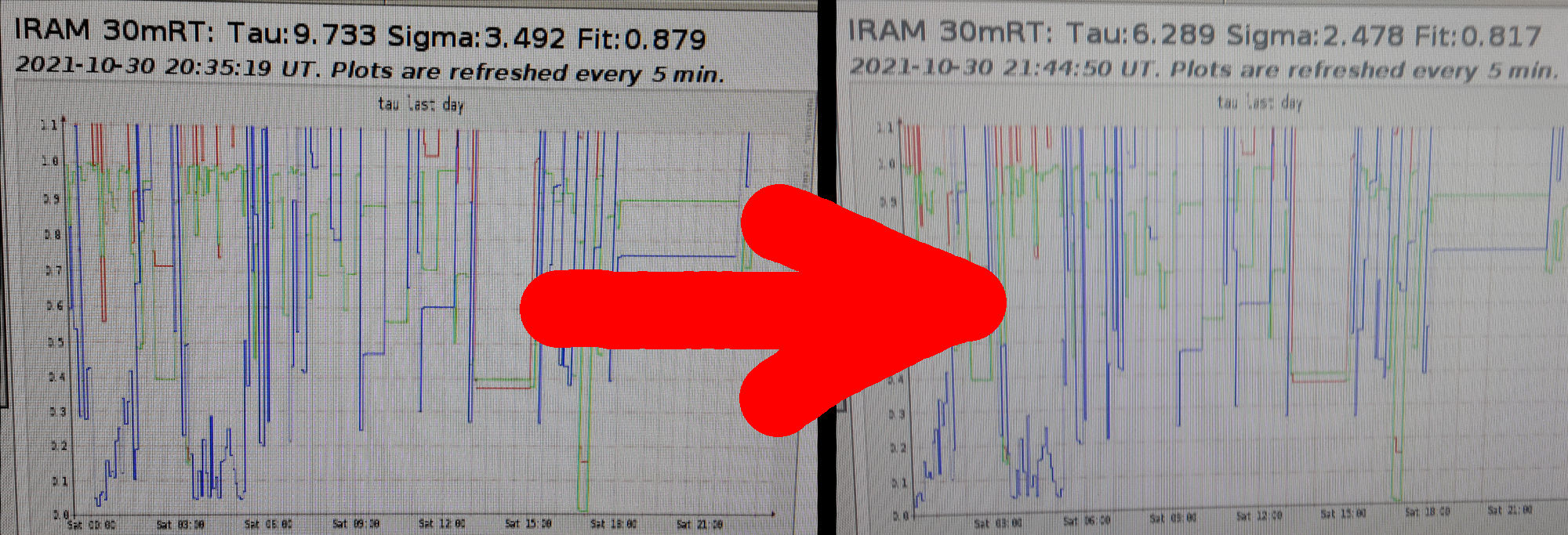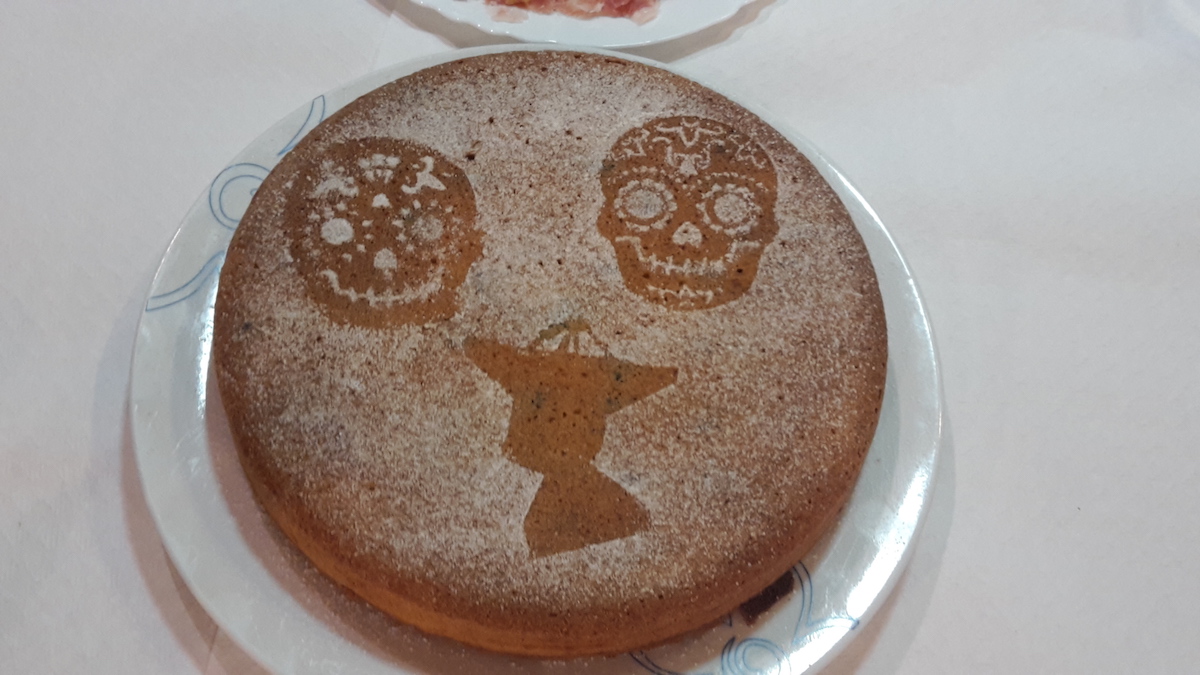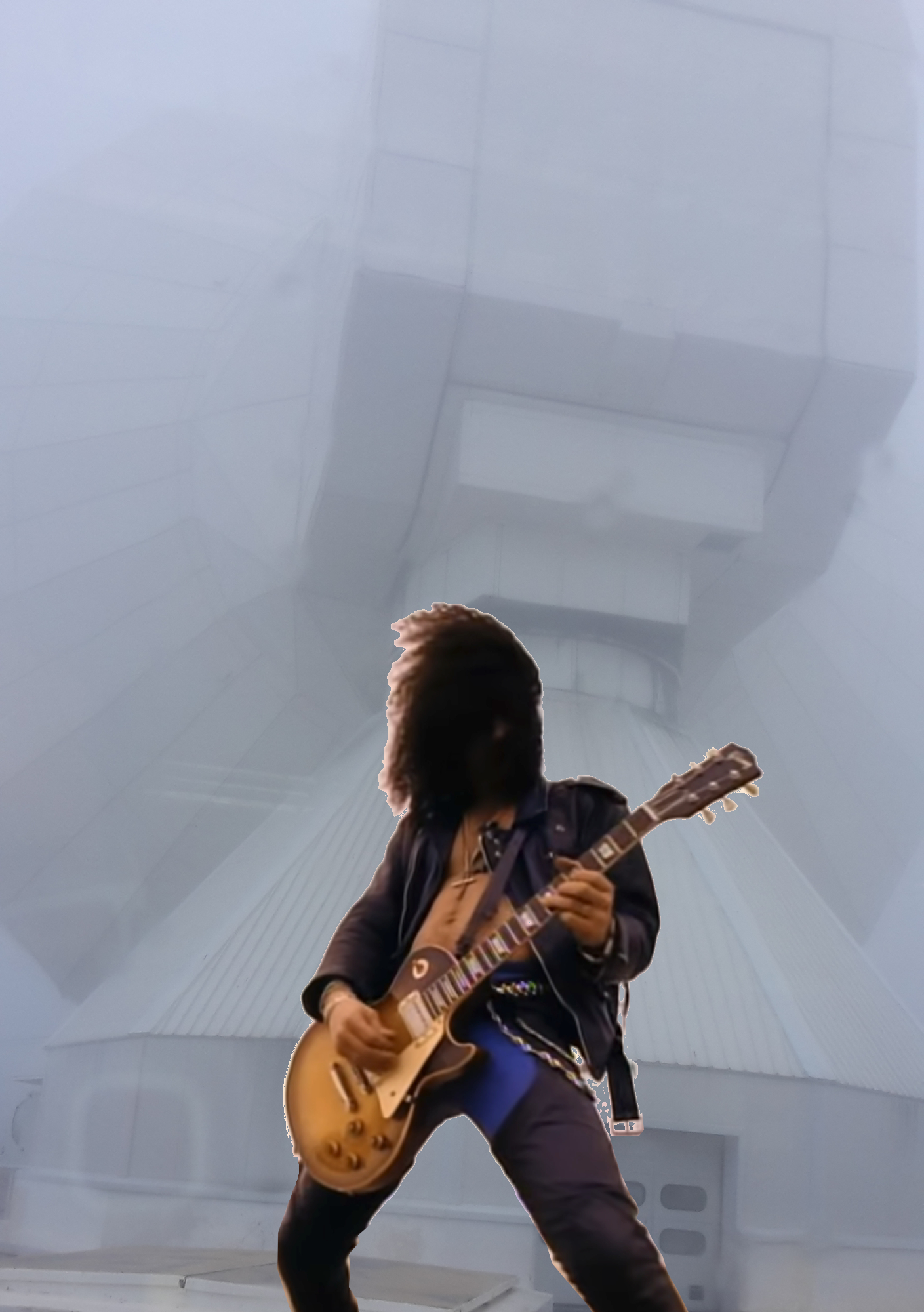Daily Reports
Because of COVID-19, only IRAM staff is allowed to observe on-site until new notice.
Contents
Note by Stefano: It's fantastic to be back. I hope everyone will soon be allowed to come observing in person, because it's a very nice feeling. I promise I'll make this Daily report colorful with some nice photos for you, when possible.
Oct 26th, Tuesday
Always using the new sweep from now on.
Currently the adopted pointing model is the one for "summer". The latest EMIR pool showed large [pointing offsets, like the NIKA2 observations of last week, therefore here we've been wondering if it's time to switch to "winter". The issue is under investigation by Manuel (deputy station manager) and soon we'll know more.
19:00-21:00-03:00 afternoon and 1st half of the night shifts. Angel and Stefano
We start late because earlier the telescope was in the clouds. Then the sky clears for a nice sunset and for letting NIKA2 have some fun :-)
We find a small typo in the Ar3 PIIC DAFs that prevents it to process the data but we have no permissions right now to fix it. Therefore we switch off the Ar3 PIIC monitor and ask RZ to fix it for us tomorrow. We also have a small hickup with the processing the focus sequences, but it does not prevent to use the PIIC monitor anyway (restarting the PIIC monitor the problem is solved). We observe the filler program 045-21 with regular pointing and focus. Skydip in scan 20211026s109. With these conditions we don't perform any beammap nor calibrators scans.
We switch to the 47.6 Hz sampling frequency (editing the .ini file) and we restarted the DAQ. This frequency is needed by the ARSENAL time filler program (086-21). After pointing/focus, we start observing 086-21 with the 47.6 Hz sampling. Note that with 47.6 Hz sampling the data files are bigger and the make-imbf process takes longer than with the standard 23.8 Hz sampling. The PIIC monitors process the 47.6 Hz data just fine. Meanwhile the sky opacity improved to an astonishing 0.3. We give the stage to the next shift.
Oct 27th, Wednesday (day 300)
03:00-09:00 Hélène, Annie: We observed project 086-21 (ARSENAL) with 5 repetitions on A520 (one already done in the previous shift, so a total of 6 so far)and 3 repetitions on A665. We were unsure about the exact elevation limit (55 degrees according to the README, 58 degrees according to the pako interface) but did not want to take any risk and switched sources before A520 got to 55 degrees. We did a focus and a calib_1scan on Uranus, and regular pointings. The 2mm FWHM varied between 17.8 and 18.2 arcsec. Opacities remained at ~ 0.3-0.35 in the first half of the shift and then fluctuated more, between ~ 0.35 and 0.7. It was very hard to gauge the stability of the atmosphere from PIIC results, because the display is tiny.
09:00-15:00 Mónica, Brisa, Stefano, Angel: We continued with project 086-21; 6 repetitions on A2218. Opacity was around 0.4 with progressively increasing instability. Pointing corrections from ~10, 9 arcsec at the morning evolved over the shift to ~15, 15 arcsec. Beam size (2 mm) about 17.5 x 18.0 arcsec with very slight variations. Stable about 65% of the time (2 to 5 Jy/beam at 2 mm). Variations of timelines reached about 17 Jy/beam for some scans. Mean noise rms (2 mm) of ARSENAL maps ~50, ext. corrected 85 mJy/beam. Stopped around 14:15 because of a sudden opacity increasing.
15:00-21:00 Isabelle, Karine, Angel, Stefano: we switch again to the sampling frequency of 23.8 Hz. The last scan at 47.6 is scan number 20211027s100. The sky conditions degraded a lot. Opacity was very high (generally above 0.8) with spikes up to 2! We get back on the question of switching the pointing model from summer to winter. Manuel applies some changes: starting from the NIKA2 summer pointing model, he applies a shift of 8 arcsec to the parameter P7 (offset in Elevation), such that P7(new) = P7(summer) + 8 arcsec. [NOTE: this is now done only for NIKA2]. We test this with new pointings and the El offset is now ok. The first scan obtained with this new pointing model configuration is 20211027s111. We observe 045-21, although the conditions are still poor. Stopped at 16:50 because due to very high opacity and dense fog.
21:00-03:00 Juan, Emmanuel, Stefano: tau~0.3. We observe the calibrators NGC7027, MWC349, Uranus (scans 153, 155, 158). Then we start to observe NGC1333-C2 belonging to 010-21 and perform 4 repetitions. We then switch to 199-16 and observe PSZ2-G111.6 (3 repetitions).
Today's challenge: try to take a sky flat-field with NIKA2:
Oct 28th, Thursday
03:00-09:00 Hélène, Annie: Conditions were stable, with only one brief spike in the opacity at the beginning. Otherwise, the opacity ranged between ~ 0.2 and 0.25. The FWHM was stable too, 17.5 to 17.7" at 2mm. We did a calib_1scan on Uranus, a skydip at 8:15 and a calib_1scan on W3OH at 07:10 (the suggested secondary calibrators were not available: NGC7027 too low, MWC349 cannot be found in the catalogs). We spent the time on project 160-16 (IMEGIN): 3 repetitions on N628, 4 on N925, 2 on N3184 and 2 on N3521. The adopted default scan speed is 80"/s whenever the source is lower than ~60 degrees.
When taking our shift, we lost half an hour due to the following problem, that took us a while to figure out: nk_get_kidpar_ref.pro had been updated to read a new kidpar, but this new kidpar has not been copied to the relevant directory. We switched back to the previous kidpar used yesterday. We were surprised that the previous observers did not say anything, although they had the same problem, judging from the IDL window showing nk_rta stopping with an error message.
09:00-15:00 Bilal, Angel: The opacity is stable at the start of the shift so we continue for one iteration on 160-16. Then we move to E03-20 for one repetition until it's too high. Opacity and atmosphere gets unstable and we have difficulties to focus for a while. After a restart of the acquisition (48 Hz) we move to project 086-21 for one repetition.
15:00-21:00 Karine, Roberta, Wanggi: We observed project 086-21 and did 3 repetitions on A2163. Acquisition restarted at 24 Hz. Then, at the end of the afternoon, the opacity was good but we had trouble getting a good focus with large atmospheric variability. We finally got reasonable pointing/focus corrections and switched to project 083-21: source J1639+4052 observed (1 repetition).
21:00-03:00 Laurence, Corentin, Stefano: Very stable sky with tau~0.2 and better. We observe 199-16 (cluster ACTJ2302, 7 repetitions). Calib_1scan on Uranus (scan 20211028s266). Beammap (h option because above 60 deg of elevation; scan 267).
Today's fauna:
Oct 29th, Friday
03:00-09:00 Hélène, Annie: Many thanks to Stefano and Laurence for a nice tutorial on how to evaluate the atmosphere stability. After pointing and focus on Uranus (sorry, we forgot about doing a calib_1scan), we attempted to observe N628 for project 160-16 but did only one repetition because the atmosphere became too unstable immediately after we began (rms > 20 Jy/beam at 2mm). These two scans will probably not be useful. Since it was expected that the conditions would degrade even more, we switched to the Bubbles time-filler (045-212) for the whole shift. We started with the GP201-202 series, then went to GP192-193. The beams were correct (17.6" to 18.6"), but at one time we had difficulty obtaining a good focus fit, even on Uranus. Opacities were moderate (~0.2 to ~0.4 at the end of the shift, with occasional big spikes), but the sky rms was too big for any other project: often reaching several tens of Jy/beam.
09:00-15:00 Brisa, Mónica, Yali (for a training primer), Angel: tau~0.4 at the beginning of the shift and unstable. We continue in project 045-21: GP192_0+0_[0, 2, 4], GP192_0+1_0, and GP192_3_+0_[0,2] observed. Large instabilities and opacity increased up to 0.6 over the first half of the shift: timeline variations of 10 to ~100 Jy/b; <rms> noise between 60 and 150 mJy/b in GP* maps gathered. At that time, all targets of project 045-21 project we below 25 degrees of elevation. Switching to EMIR backup programs. Opacity increasing up to 0.8-0.9. Several pointing attempts in E0. Signs of anomalous refraction. Opacity triggered > 1. Telescope stopped at 13:20.
15:00-21:00 Karine, Roberta, Wanggi: On-hold. Telescope stopped. Adverse weather.
21:00-03:00 Stefano, Laurence, Miren. The telescope is parked. Enjoy the show that Mother Nature offered us today...
Oct 30th, Saturday
Telescope stopped all day. Strong wind, dense fog, and rain.
In the evening we notice a significant improvement of tau:
Oct 31st, Sunday
Stopped all day. Rain, fog.
We celebrate too:
Nov 1st, Monday
Stopped all day. Rain, fog.
This is our theme today: https://www.youtube.com/watch?v=8SbUC-UaAxE
Nov 2nd, Tuesday
03:30: Mean opacity tends to values of 0.7-0.8. Fog dissipates. Wind speed is about 5 m/s, although the relative humidity is quite high. Acquisition restarted at 24 Hz. Setting cryostat level to attente. Trying on Uranus for pointing/focus and examining stability. Highly unstable: baseline variations between 50 and 100 Jy/beam, depending on the band. Vertex closed/telescope stopped for ~1 hour due to fog. Trying on Uranus again. New pointing scans get corrections ~10 arcsec higher than the previous ones, reasonable beam size/shape. Relative humidity on 100% according to the station. Frédéric Damour gets several hygrometer measurements that differ about 40% wrt the value given by the station, which would say that correction by refraction could be altered. After correcting manually the relative humidity and launching a new pointing scan, corrections are again around the expected values. Still unstable. Change to project 045-21. Observing GP139_3+0_[0,2,4]. Two scans were canceled in the middle because of a problem with the azimuth brake. Opacity drops to ~0.3, but forecasts point out a rapid increase. Observed GP148_3-0_2, and GP148_3+0_[0,2,4]. A skydip (20211102s36) followed that (relatively stable: +/- 5 Jy/beam at 2 mm). Then, we observed the GP189_0+0_[0,2,4] and GP189_3+0_[0,2,4] with opacity about 0.4 to 0.5. The shift was finished at 10:40 by pointing/focus on Mercury to get a calib_1scan (20211102s63).
Many thanks to all the observers who participated in this Pool week.


